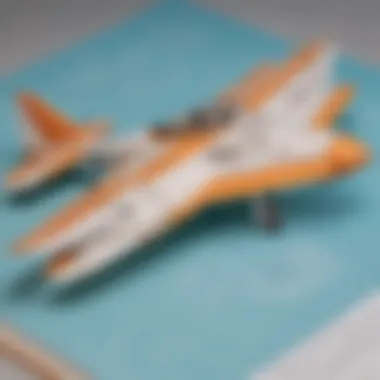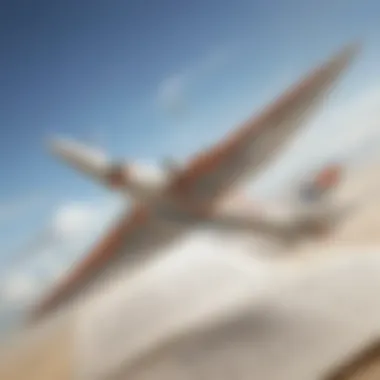Step-by-Step Guide on How to Construct a Paper Airplane for Kids


Science Fun Facts
Paper airplanes have been a source of fascination for generations, captivating young minds with their simplicity and aerodynamic wonder. Did you know that the record for the longest paper airplane flight stands at an impressive 226 feet and 10 inches? It's truly astounding how a simple fold of paper can defy gravity and soar through the air with grace and precision.
Discover the Wonders of Science
Let's unravel the science behind paper airplanes and explore the fundamental principles of flight. From understanding lift and drag to discovering the optimal weight distribution for stability, delving into the physics of aerodynamics can spark curiosity and ignite a passion for scientific inquiry among budding aviators.
Science Quiz Time
Are you ready to test your knowledge of paper airplane engineering? Put your skills to the test with interactive quizzes designed to challenge young minds and foster critical thinking. Can you identify the factors that affect a paper airplane's flight path? Put on your thinking cap and dive into the world of aerodynamics through engaging brain teasers and puzzles.
Science Experiment Showcase
Embark on a hands-on journey of exploration with fun and engaging paper airplane experiments. Follow step-by-step instructions to fold and launch different designs, exploring how variations in shape and weight can influence flight performance. Stay safe with valuable safety tips and precautions, ensuring a fun and secure learning experience for all aspiring young scientists.
Introduction
In commencing the endeavor of constructing a paper airplane, understanding the fundamental concepts of aerodynamics becomes imperative. At the core of this intricate craft lies the marriage between precision paper folding and the nuanced laws of physics governing flight. This section aims to demystify the enigmatic realm of aerodynamics, providing insights that will guide young engineers on an exhilarating journey through the skies of creativity.
Understanding Aerodynamics
Explaining Lift and Drag
When delving into the ethereal domain of flight, the aspects of lift and drag emerge as pivotal forces shaping the trajectory of aircraft. Lift, the upward force defying gravity, and drag, the resistant force acting in opposition to movement, converge to orchestrate the graceful dance of a paper airplane through the air. Unraveling the nuances of these phenomena not only enlightens young minds but also sets the stage for mastering the art of paper aircraft design.
Factors Influencing Flight
Beyond the intrinsic realms of lift and drag, various factors intricately influence the flight characteristics of a paper airplane. From subtle adjustments in weight distribution to the shape of the wings, each element intricately weaves together to determine the airborne prowess of the paper creation. By comprehending these underlying factors, young aviation enthusiasts can harness the power of knowledge to propel their paper planes to new heights.
Importance of Paper Folding Techniques
The crux of aerodynamic mastery in paper airplane construction lies in the delicate art of paper folding. Each crease, bend, and taper contributes to the aerodynamic efficiency of the aircraft, dictating its stability and flight dynamics. Savoring the importance of precise paper folding techniques not only refines the aesthetic appeal of the paper plane but also serves as a testament to the meticulous craftsmanship required in aerodynamic endeavors.


Materials Required
Embarking on the paper airplane construction odyssey necessitates the procurement of essential materials that serve as the building blocks of aerodynamic ingenuity. From selecting the ideal paper type to precision tools aiding in accurate folding, this section illuminates the significance of quality materials in shaping the destiny of paper flight.
Types of Paper Suitable for Folding
The choice of paper fabricates the foundation of an exceptional paper airplane journey. From origami paper to lightweight cardstock, each variant bestows unique characteristics upon the final aerial creation. By delving into the distinct properties of paper types suitable for folding, aspiring aviators can meticulously select the medium that aligns seamlessly with their flight aspirations.
Additional Tools for Precision
Beyond the realm of paper, the arsenal of additional tools for precision offers a gateway to meticulous craftsmanship in paper aircraft construction. From rulers ensuring exact measurements to scissors sculpting intricate details, these tools elevate the art of paper folding to a precision-driven spectacle. Nurturing young minds to appreciate the role of accurate tools fosters a culture of meticulous innovation in the realm of paper flight.
Step-by-Step Instructions
In the captivating realm of paper airplane design, mastering the rudimentary steps unfolds a tapestry of creativity bound only by the limits of imagination. From crafting a sturdy foundation through the basic paper plane design to unraveling the secrets of stability through strategic folding techniques, this section unveils the key to mastering the artistry of paper flight.
Basic Paper Plane Design
At the heart of every paper aviation venture lies the foundational design of the paper plane. The ingress into this dynamic world commences with mastering the simple yet profound principles governing the construction of the elemental paper aircraft. By inculcating the basics of paper plane design, young enthusiasts embark on an odyssey replete with limitless possibilities to mold their airborne dreams.
Folding Techniques for Stability
The fortification of a paper airplane against the caprices of flight turbulence hinges upon the strategic deployment of folding techniques conducive to stability. From precise symmetrical folds to tapered edges enhancing aerodynamic sleekness, each fold embodies a narrative of resilience against the winds of uncertainty. Embracing these folding techniques not only elevates the stability of the paper aircraft but also instills a sense of meticulous craftsmanship in the young aviators.
Tips for Achieving Distance and Speed
Achieving the zenith of flight performance requires a harmonious blend of distance prowess and speed proficiency. Each aerodynamic adjustment, from the angle of launch to the meticulous creases along the wings, ushers the paper creation into a realm where velocity meets endurance. These insightful tips not only refine the flight mechanics of the paper airplane but also kindle the spirit of innovation in the relentless pursuit of flight perfection.
Testing and Adjustments
The manifestation of a paper creation gliding through the skies heralds a series of exhilarating tests and adjustments aimed at refining the artwork of flight. From mastering the finesse of launch techniques to deciphering the cryptic language of flight patterns, this section unveils the realm of iterative improvements necessary for unlocking the true potential of a paper aircraft.
Launching Techniques
The transformative instant of launch embodies the culmination of meticulous preparation and eager anticipation intertwining in a fleeting spectacle. Mastering the art of launching a paper airplane transcends mere propulsion; it encapsulates a nuanced dance of force application, angle precision, and trajectory calculation. By absorbing the intricacies of launching techniques, young aviators unveil the gateway to endless skies brimming with flight possibilities.


Observing Flight Patterns
The choreography of flight patterns etched across the canvas of the sky serves as a visual symphony echoing the aerodynamic nuances dictating the motion of a paper airplane. Decoding these ephemeral patterns not only enriches the flight experience but also offers profound insights into refining the flight dynamics for optimal performance. Through keen observation, young aviators unlock the secrets of flight hidden within the rhythmic patterns of aerial dance.
Making Modifications for Improved Performance
Striving for the pinnacle of flight excellence necessitates a willingness to tread the path of relentless adjustments and modifications. Each tweak in wing shape, weight distribution, or structural integrity unfolds a transformative journey toward enhancing the overall performance of the paper aircraft. By embracing a culture of iterative improvements, aspiring aviators usher their paper creations into a realm of unparalleled flight mastery.
Enhancing the Design
Beyond the realms of functional flight mechanics lie the embellishments that bestow a personal touch of creativity upon the paper aircraft. From adorning the wings with added weight for enhanced stability to experimenting with varied wing shapes, this section propels young aviators into a realm where aesthetics and innovation converge to redefine the very essence of paper flight.
Adding Weight for Stability
The judicious inclusion of weight introduces a touch of stability to the delicate equilibrium governing the flight dynamics of a paper creation. By strategically placing weights along specified points, young engineers sculpt a pathway to enhanced control and maneuverability in the ethereal expanse. Delving into the art of weight addition not only fortifies the paper aircraft but also instills a sense of precision engineering in the aspiring aerodynamic connoisseurs.
Experimenting with Wing Shapes
The experimentation with wing shapes transcends the boundaries of conventional flight aesthetics, ushering young aviators into a realm where innovation reigns supreme. From delta wings to swept-back wing configurations, each experimentation unfurls a vista of aerodynamic unpredictability waiting to be harnessed. Embracing the journey of experimenting with wing shapes fosters a culture of fearless exploration, paving the way for paper creations that defy traditional flight norms.
Decorative Elements for Personalization
The celestial tapestry of flight receives a touch of personal flair through the incorporation of decorative elements adorning the paper aircraft. From vibrant colors painting the wings to elaborate patterns embellishing the fuselage, each decorative accent tells a story of creativity and individuality. Imbuing the paper creations with decorative elements not only elevates the aesthetics of flight but also sparks a sense of ownership and pride in the artisan engineers.
Understanding Flight Physics
The canvas of flight unfurls a mesmerizing saga of physical principles interwoven into the very fabric of aerodynamic exploration. From unraveling the effects of weight distribution on flight dynamics to delving into the intricate dance of aerodynamic principles shaping motion, this section unravels the profound mysteries governing the celestial ballet of paper aviation.
Effects of Weight Distribution
The distribution of weight serves as a silent maestro orchestrating the ballet of flight dynamics performed by a paper creation. Every subtle shift in weight distribution engenders a fundamental alteration in the aircraft's stability, control, and maneuverability. By dissecting the effects of weight distribution, aspiring aviators peel back the layers of flight physics to unveil the intricate balance between gravitational forces and aerodynamic finesse.
Exploring Aerodynamic Principles
Venturing into the chimerical realms of flight requires a deep dive into the ocean of aerodynamic principles that govern the skies. From Bernoulli's principle shaping lift to Newton's laws dictating motion, each fundamental principle guides the flight path of a paper creation through the unseen currents of air. Embracing the exploration of these aerodynamic principles not only enriches the flight experience but also lays a solid foundation for a lifelong journey of scientific inquiry and discovery.


Impact of Wind Conditions on Flight
The whispering winds of change wield a profound influence on the delicate ballet of flight enacted by a paper aircraft. Understanding the impact of wind conditions on flight dynamics is essential for navigating the turbulent seas of aerodynamic unpredictability. By unraveling the symbiotic relationship between wind currents and flight behavior, young aviators equip themselves with the knowledge necessary to soar gracefully amidst the ever-shifting atmospheric currents.
Safety Precautions
Amidst the exuberant thrill of flight experimentation, prioritizing safety precautions stands as a sacrosanct duty incumbent upon seasoned aviators and aspiring engineers alike. From ensuring the safe construction of paper planes to delineating supervision recommendations for young flyers, this section underscores the paramount importance of fostering a culture of safety consciousness in every flight endeavor.
Tips for Safe Paper Plane Construction
The genesis of flight embarks upon a foundation of safety conscious construction practices that safeguard both the aircraft and its creators. Instilling the ethos of safe paper plane construction not only mitigates potential risks but also cultivates a culture of meticulous craftsmanship and responsible engineering. By adhering to safety guidelines, young aviators pave the way for a flight journey enriched by caution and conscientious creativity.
Supervision Recommendations for Young Flyers
In the realm of aeronautical exploration, the presence of seasoned supervision serves as a guiding beacon illuminating the flight paths of young aspirants. These recommendations form a protective cocoon around fledgling aviators, ensuring a nurturing environment conducive to joyful flight experimentation. By embracing the mantle of supervision, parents and caregivers instill a sense of reassurance and mentorship in the budding aviation enthusiasts, fostering a culture of safe and enjoyable flight exploration.
Conclusion
Summary of Key Points
Importance of Precision in Folding:
Delving into the importance of precision in folding paper airplanes, it becomes evident that attention to detail plays a critical role in determining the success of each flight. By meticulously following the folding instructions, enthusiasts can achieve optimal aerodynamic properties, resulting in improved stability and distance. Precision in folding not only enhances the performance of the paper aircraft but also serves as a foundation for grasping essential concepts in physics and engineering. Although time-consuming, the meticulous nature of precision folding ultimately leads to a more rewarding and educational experience for young learners.
Experimenting with Designs:
Exploring various design possibilities is integral to the learning process of building paper airplanes. By encouraging experimentation, individuals can witness firsthand how alterations in wing shape, weight distribution, and folding techniques influence flight performance. Experimenting with designs not only sparks creativity but also cultivates problem-solving skills by analyzing the cause-and-effect relationships in aerodynamics. While each design iteration may not always lead to success, the iterative process of experimentation instills a sense of resilience and adaptability in young learners.
Encouraging STEM Learning Through Play:
Endorsing STEM (Science, Technology, Engineering, Mathematics) learning through playful activities like paper airplane construction instills a sense of joy and wonder in children. By engaging in hands-on experimentation, young enthusiasts develop a deeper appreciation for scientific concepts and principles. The interactive nature of crafting paper airplanes fosters a dynamic learning environment where creativity and logic converge, promoting holistic skill development. Through play, children can intuitively absorb complex scientific phenomena, laying a strong foundation for future explorations in STEM fields.
Final Thoughts
Inspiring Creativity and Innovation:
Inspiration is a key driver in sparking creativity and innovation among young minds engaged in paper airplane construction. By introducing novel ideas and unconventional approaches to design, individuals are encouraged to think outside the box and push the boundaries of traditional aerodynamics. Inspiring creativity through the art of paper folding not only results in unique and imaginative aircraft but also nurtures a mindset of exploration and risk-taking. Embracing creativity empowers children to see challenges as opportunities for innovation, fostering a culture of out-of-the-box thinking.
Continued Exploration of Aerodynamics:
Continual exploration of aerodynamics opens doors to a world of endless possibilities and discoveries for aspiring young aviators. By deepening their understanding of airflow, lift, and drag, enthusiasts can refine their paper airplane designs and enhance flight performance. The ongoing exploration of aerodynamic principles encourages constant learning and adaptation, instilling a sense of curiosity and scientific inquiry in budding scientists. Through consistent experimentation, children gain valuable insights into the intricate workings of flight, paving the way for future innovations in aviation and engineering.







